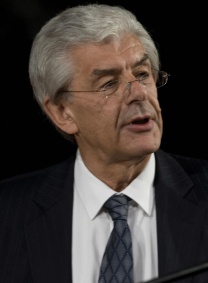|
Edited
by Frank R. Shaw, FSA Scot, Dawsonville, GA, USA
Email:
jurascot@earthlink.net
The following article by
Professor Christopher Whatley appeared in the January 2011 issue of the
BBC History Magazine.
Professor Whatley is
Professor of Scottish History, a distinguished and active historian who has
risen through the ranks since joining the University of Dundee in 1979 as
lecturer. His most recent book, The Scots and the Union (Edinburgh
2006), a seminal study launched to coincide with the 300th
anniversary of the Union of the Parliaments, met with critical acclaim and
was described as essential reading for anyone who wants to understand the
making of modern Scotland.
Under his headship History
(5 rated) at the University rose to be recognized as among the best in the
country.
A graduate of the University
of Strathclyde, where he also took his PhD, Professor Whatley has published
considerably, including authorship of six substantial books, editorship of
nine books and approximately 60 other works. He has been an external
examiner for programs in Scotland and the European Union and is a member of
Peer Review College of the Arts & Humanities Research Council and the Royal
Society of Edinburgh of which he is also a member of the Council. He is in
frequent demand by TV, radio and print media as consultant, presenter and
contributor. He is also a founder director and chair of the editorial board
of Dundee University Press.
Thanks to Professor Whatley
for his courtesies in sharing this article with our readers. We also
appreciate the support of Aileen Ross for her added assistance.
(FRS: 5-9-2012)
Robert Burns
Patrician Protégé, People’s Poet

Professor Christopher
Whatley
On a grey, sleet-spattered
Thursday in 1877, a vast crowd comprising an estimated 100,000 people
crushed into Glasgow’s George Square. Others watched from windows and even
rooftops, while in the surrounding streets thousands more strained to catch
at least part of the proceedings. The occasion, which had been preceded by a
colorful procession of the city’s trades, accompanied by the cacophonous
sounds of 30 or so bands struggling to play the same tune at the same time,
was the unveiling of a statue of Robert Burns, Scotland’s national poet. The
day chosen was 25 January, the date of Burns’s birthday, in 1759.
The scale and extent of
public participation surrounding the Glasgow unveiling ceremony were neither
unusual nor unprecedented. Much earlier, in 1796, Burns’s death had induced
the kind of emotional reaction we associate nowadays with the deaths of
celebrities – President JF Kennedy, Princess Diana or most recently Michael
Jackson. ”Great was the grief of the people for their poet’s death,” wrote
one of Burns’s contemporaries. “They felt they had lost their greatest man.”
Dumfries, where Burns spent
the last years of his life as an excise officer, and where he died, was
“besieged” for his funeral. It was again for the funeral of his wife, Jean
Armour, almost 40 years later. Collections of Burns’s works poured from the
presses. There was a deepening hunger for biographical details of his life.
Apparent too was a morbid but intense and widespread interest in Burns’s
mortal but now immortalized remains, including from phrenologists who
examined his skull.
Pilgrims flocked to places
associated with Burns and his poems and songs. Relic hunters stripped bare
the timbers of the ruins of Alloway Kirk, scene of one of Burns’s best-known
poems, Tam O’ Shanter. Dumfries, where Burns’s mausoleum in St
Michael’s churchyard was located, became Scotland’s Jerusalem. Over time
entire industries emerged to satisfy the demands of Burns-lovers for busts,
statuettes, engravings, snuffboxes and a multitude of other Burns ephemera.
Memorials and statues abounded, principally in Scotland, but several were
erected in Canada and the United States, Australia and New Zealand.
Just how massive the Burns
phenomenon was became clear in August 1844 at the first ever Burns Festival
– held in Ayr, within sight of his birthplace. Estimates of the numbers
present ranged from 50,000 to 80,000. The unprecedented level of
participation attracted nationwide interest, not least on the part of London
journalists and others who sought to understand why a Scottish poet should
have aroused such fervour on the part of those present.
Behind the festival, as with
the memorials that had been built in Burns’s memory prior to 1844, were
representatives of Scotland’s older ruling class. Along with the arch-Tory
academic, Edinburgh University’s Professor John Wilson, Scotland’s emergent
commercial and manufacturing elite also played a leading role, including Sir
Archibald Alison, Glasgow’s sheriff and scourge of working-class radicalism.
The motives that lay behind such patrician promotion of Burns were mixed.
Guilt was one; they had allowed the poet to die in poverty. As important
however was Scottish patriotism. The festival organizers recognized that
Burns, much of whose work was written in Scots, had been instrumental in
preserving the Scottish language and dialect.
This they saw as the essence
of Scottish identity – under threat in the united British kingdom. In this
respect Burns appealed across party lines as well as class boundaries, and
he united lowland Scotland – even if there were clergymen who deplored the
elevation to secular sainthood of a poet who had celebrated drink – fuelled
excess and mocked the Kirk.
Central to the Ayr festival
project however was the presentation of Burns as the epitome of
pre-industrialised Scottish society in which pious peasants knew their place
and stoically accepted their lot. The festival’s organizers employed as
their manifesto for this ideal world Burns’s poem, The Cotter’s Saturday
Night, which could be read as a recipe for personal, familial and social
contentment. Scottish conservatives were anxious not only to preserve such
characteristics, but also to promote them as a bastion against the forces of
industrialisation, urbanisation and revolution.
Yet what was also apparent
to observers in 1844 was that the ordinary people present – tradesmen,
ploughmen and shepherds predominated – had their own views about Burns. What
inspired them were lyrics like “A man’s a man”, the tune to which they had
chosen to march in the procession that preceded the festival. That Burns was
more popular than Sir Walter Scott among Scottish artisans, concluded one
group of interested spectators, was due to the fact that Burns had been a
sinner but also that he was a democrat, something that the organizers were
at pains to ignore or even deny.

Professor Christopher
Whatley in July 2008
Ironically, even within
The Cotter’s Saturday Night were lines and potentially corrosive
sentiments they were unable to censure, including the following:
Princes and lords are but
the breath of kings,
‘An honest man’s the noble work of GOD:’
And certes, in fair Virtue’s heavenly road,
The Cottage leaves the Palace far behind:
What is a lordling’s pomp? A cumbrous load,
Disguising oft the wretch of human kind,
Studied in the arts of Hell,’ in wickedness refin’d!
Radical attacks on the
festival began almost as soon as it was over. Do not feast upon your poet’s
grave, “Having first starved him into it”, thundered Feargus O’Connor in the
Chartist Northern Star. The charge echoed the comments of a Chartist
lecturer who had visited the Burns monument in Alloway the previous year. He
acknowledged that it was a fine structure, a fitting “shrine to genius”. Yet
it did not reflect well on the class that had erected it: whoever recalls
Burns’s death-bed appeal for five pounds, he wrote, will regard “this cold
stone pile as a monument to the meanness as well as pride, of the Scottish
aristocracy.
Burns’s appeal to the
respectable working classes in Scotland was multifaceted. His poetry
captured what for many was a familiar if rapidly disappearing rural way of
life; he ignited the smoldering embers of Scottish national consciousness.
As someone who had self-consciously portrayed himself as a “heaven taught”
ploughman, Burns offered hope for ordinary people that they could rise above
the circumstances of their birth.
Indeed Burns inspired a
small army of British worker-bards. Resonating even more strongly was his
egalitarianism. Many thousands of working people contributed their single
shilling to the Glasgow Burns statue fund. In Dundee too, workers subscribed
to the cost of the Burns statue unveiled in October 1880.
Resounding cheers from what
had been the largest crowd in this jute manufacturing town’s history were
heard when the main speaker on the occasion, Frank Henderson MP, pronounced
that by showing “the nobility of the soul was confined to no rank”, and that
the “honest man was the noblest work of God”, Burns had transformed the
lives of Scottish workers. But Burns’s capacity to inspire was not confined
to Scotland. His influence was felt among weaver communities in Ulster from
the 1790s, and Burns was adopted as the poet of the early American republic.
Indeed, Abraham Lincoln was among his most ardent readers and admirers,
frequently quoting lines from his poetry.
Burns suppers, the first of
which was held in 1801, are now ubiquitous, with perhaps nine million
attending them worldwide as recently as January 2009. The Burns being
celebrated will differ widely from place to place. What will unite those
present will be the consumption of “mountains of haggis”, (too) much whisky,
and spirited renditions of his poems and songs – ending with Auld Lang
Syne.
The best of them will
acknowledge Robert Burns’s importance in promoting – in simple but
unforgettable language – ideas and aspirations that lifted the spirits of
countless thousands of ordinary people in the long march towards democracy. |
